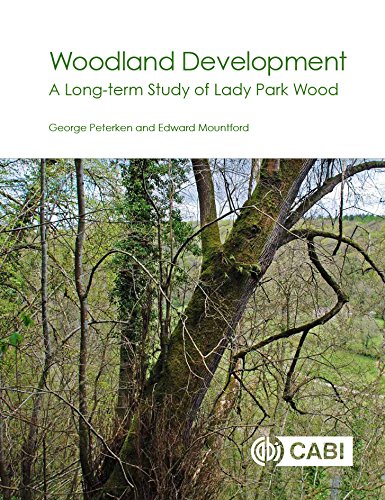From Living Woods Issue 50
Woodland owner DUNCAN DAVIDSON is inspired by the
long-term study of Lady Park Wood.
 WOODLAND DEVELOPMENT:
WOODLAND DEVELOPMENT:
A LONG-TERM STUDY OF
LADY PARK WOOD
George F. Peterken and
Edward P. Mountford
CAB International, 2017
302 pages with colour illustrations
ISBN 978-1780648651
This book is about an unmanaged, ancient wood in the lower Wye Valley. Among books on woodlands, this one is unique. Here are observations made over the course of 70 years on 21,000 individual trees and interpreted in a beautifully rounded way by two leading forest ecologists who have been involved in the study for many years.
Lady Park Wood was set aside by the Forestry Commission in 1944 for long-term ecological study: 36 ha of mixed beech, sessile oak, ash, lime, wych elm, birch and yew. The wood had been coppiced until 1870, then allowed to grow with light thinning until 1942 when part was felled and allowed to regenerate naturally. The ‘old growth’ stand developing since 1870 and the ‘young growth’ stand have lived without human intervention since 1944 (the reserve was deer-fenced in 2007). Observations on the two stands combine (approximately) to give a picture of woodland development over 145 years. For comparison, 8 ha of adjacent, unfenced wood was added in 1984, managed by periodic thinning and natural regeneration. The Nature Reserve Agreement extends to 2083.
This is not dry science; the pages are inhabited by people as well as trees. But Peterken and Mountford give no ground to superficiality. They discuss methods for measuring the growth of stands and of single trees, describe overall stand development then deal with each tree species in turn, often illustrating points by reference to the growth and fate of individual trees. There are many excellent colour photographs and the work is fully referenced. Tables of results allow the reader to compare quantitatively, say, regeneration with mortality or basal area with stem number for different species during successive periods. Build-up of deadwood, changes to ground flora, bryophytes, lichens, fungi and animals are described. All these observations are related to the wider picture, to ways of managing ‘natural woodland’ and the desirability – or otherwise – of ‘rewilding’.
Lady Park Wood will be referred to by foresters and ecologists, but will also inspire those who own small woodlands or simply enjoy being in the forest. As I read it, I became increasingly aware of the story told by the distribution of species, ages and sizes of trees in my small wood. I began to appreciate some of the points highlighted by the study, for example the relative importance of vegetative regeneration for several tree species and the long persistence of beech ‘saplings’ under closed canopy and their opportunism if the canopy is opened by tree fall. Perhaps most importantly, I saw that, despite my best laid schemes, in the long view the future of my wood is unpredictable. Rare events – drought, storm, disease coming at particular moments in the life history of the wood – may radically change the balance of dominant species as they have done more than once in Lady Park.
This is not a textbook of woodland management or a plea for minimum intervention. It’s about getting to know one ‘natural’ wood in depth over a long time. In doing so, it brings us very close to the key issues for all ecological aspects of management and provides a solid background against which to judge our options. Reading this book will surely change the way you see your favourite wood.